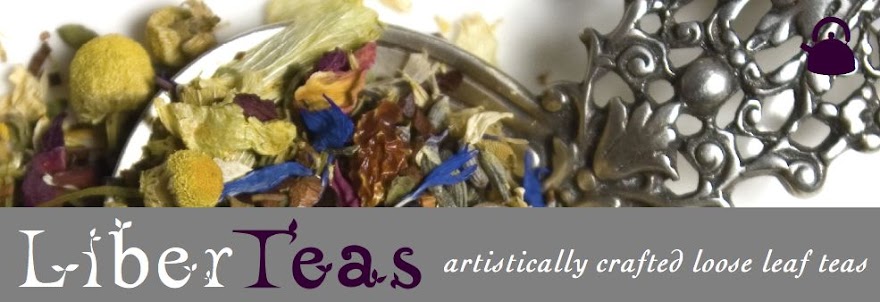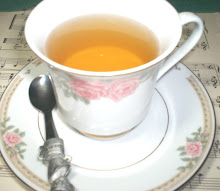Hello everyone:
This is a question that I'm asked rather frequently, even though I provide brewing instructions that are printed on the labels of my teas. There is so much "out there" about how to brew Chai tea properly, that it has caused a great deal of confusion.
So let me say this right up front, the way I brew chai tea is NOT the traditional way that Chai tea is brewed. Traditionally, you would brew your chai tea leaves and spices in a pan of simmering milk (or a blend of half milk, half water) and allow your tea leaves and spices to steep in the milk. After allowing to steep for several minutes, the mixture is strained, and then honey is added and it's served, sometimes with steamed milk. The Chai tea concentrates that are available commercially and that are used in coffeehouses to make Chai lattes uses a variation of this method, usually including the sweetener, to make their product.
The first few cups of Chai that I made in my own home were made using this method, and I have to say that after I had made those first few, I was reluctant to make more, because it makes an incredible mess! First of all, I don't like to heat milk, it is a messy endeavor at best, and I only do it when I really want a cup of rich hot cocoa (yes, I do drink beverages other than tea! Just not as often). I made the mistake of once attempting to heat milk in my electric tea kettle, and let me just say -- don't try this at home. Not a good plan.
So, when I decided that I really wanted a Chai tea blend in my collection, I first began sampling the other chai blends that were available out there, I mean, let's face it, every tea company out there has a chai tea these days, don't they? So, I thought to myself, there was no need to reinvent the wheel if I could find a chai that I like, why not add that to my collection.
The next thing on my agenda was to determine what I wanted out of a Chai tea. I wanted a Chai that was robust with spices. I wanted something that rivaled the best coffeehouses chai lattes without the complication of having to steam milk. But most of all, I wanted simplicity in the brewing process. None of this brewing in milk nonsense. I wanted something that I could easily steep in boiling water for a few minutes, add a bit of honey to, and then add milk or cream to (my preference is half & half), and have a cup of rich, satisfying chai.
Unfortunately, none of the teas that I was sampling from my suppliers fit that bill. Most of the teas stood up well to the water brewing process, however, when I added the milk or cream to the tea, much of the flavor became masqued rather than enhanced by this addition, which was the opposite of what I was looking for. The addition of milk should always enhance a tea, never detract from the flavor.
So I set out to create my own blend, and the results of months (and months, and months!) of flavoring, blending, and sampling, and then trying again, and again... is my Masterpiece Chai. This is a tea that tastes really great when served hot, with just a drizzle of honey. It also tastes remarkable when you add a splash of half and half. It's not the same thing as the coffee house chai latte, but I prefer my chai over those, because mine is not overly sweetened with corn syrup and the like. And I know what I've put into my chai... just tea: High Grown Ceylon and Assam; and Marsala Spice, a touch of vanilla, and honeybush (this adds just a bit of natural sweetness to the blend without ever overtaking any of the bold spice). So, whether it is proper or not, here is how I brew my cup of Chai:
So, whether it is proper or not, here is how I brew my cup of Chai:
- Start with fresh, cold water from the tap. I filter mine with one of those countertop filter pitchers. Bottled water should never be used to brew tea, as full flavor of tea will never be obtained using bottled water.
- Bring the water to a boil. I use an electric tea kettle for this. It's fast, and a lot more convenient than the stovetop models, however, if a stovetop model is what you have, it will work just fine. Water should be brought to a gentle boil, do not overboil the water, though, as it will brew a flat tasting tea.
- Warm your teapot. You can do this by adding some boiling water to the teapot, swill the water around until you can feel the warmth on the outside of the pot. This is an important step if you wish to keep your tea warm, as the chill of the pot can rob the tea of it's heat rather quickly.
- Use 1 1/2 teaspoons of Masterpiece Chai tea for every cup of tea you are brewing. Usually, you would use just a teaspoon of tea for each cup, however, since there is an abundance of spice (and bulky spice, at that!) in my Chai tea, you will want to manipulate the amount that you use to make sure you're getting full flavor.
- Now, when it comes to brewing loose leaf tea, there are those who use infusers, and those who do not. I usually do use an infuser, because I've found that it's a) easier to clean up; and b) it's easier to re-use the leaves for a second brewing. If you choose not to use an infuser, that's fine, just place the loose leaf tea directly into your warmed teapot. If you do choose to use an infuser, be sure that the infuser you choose offers ample room for your tea leaves to expand. Most tea leaves will expand to three times their dry volume. If they aren't given enough room to expand, then you will lose flavor. I use a chatsford teapot, and I've found that the nylon infuser that is provided with the teapot works well in allowing enough room for the tea leaves to expand. (and yes, I've tried it both ways -- with and without the infuser -- and have found no discernable difference in flavor) Just make sure that you have enough water to fill the teapot, thereby allowing the water to come to the top of the infuser and filter through the leaves adequately, and don't forget to add enough loose leaf tea for this amount of water... if you're using a 4 cup teapot, for example, you'll need 6 teaspoons of Masterpiece Chai tea.
- Gently pour the boiling water over the tea leaves, and steep for 4 minutes. This is the time I use. You might want to play around with the time until you find your perfect time. Everyone's palate is different!
- Remove the tea leaves, and serve. I add a good size drizzle of honey (it would probably equal about a teaspoon and a half if I were to measure how much I use). Alternatively, I have used Agave Nectar in my chai tea with pleasant results, but I find that the honey adds a certain authenticity to the chai. Add a splash of half & half (again, if I were to measure how much I use, it would probably equal about a teaspoon, perhaps a teaspoon and a half), and stir until the honey has been dispersed throughout the tea.
~Anne





1 comments:
!sounds delicious and just what I need to off set this winter chill:) Jenelle
Post a Comment